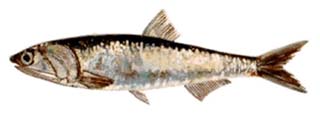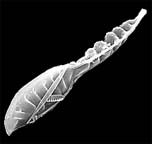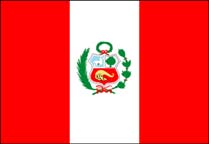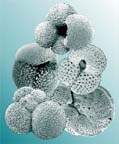|
|
|
|
|
The list of
organisms directly involved in this case have been narrowed to four groups.
Provided for you are some general information about the organisms' eating
habits, size, and other notes. Create a diagram
showing the relationships between the organisms.
|
| FISH |
|
Anchovy
- Engraulis
ringens
- DIET:
zooplankton & phytoplankton
- DISTRIBUTION:
Peruvian & Chilean coasts
- PREDATORS:
Large fish, guano birds, marine mammals, humans
- NOTE:
a.k.a. anchoveta, anchoa; juvenile anchovy = peladilla
(sealevel2.jpl.nasa.gov/jr_oceanographer/images/o-carr-anchovy.jpg;
Jordan, 1980).
|
 |
|
Other
plankton-eating fish
- Brevortia
m. chilcae (machete) and Sardinops sagax (sardine)
- DIET:
zookplankton & phytoplankton
- DISTRIBUTION:
- PREDATORS:
- NOTE:
These pelagic schooling fish are at the same trophic level
as anchovies. They can be considered predators of the anchoveta
because their zooplankton diet also include anchovy eggs
and larvae.
(www.neptunetrading.com/pacificsardines.htm; Jordan,
1980)
|
 |
|
|
|
|
| Guano
birds |
|
|
  
|
-
Peruvian pelican (Pelicanus thagus), Peruvian booby
(Sula variegata), and Guanay cormorant (Phalacrocorax
bougainvillii).
- DIET:
anchovy, squid, sculpin
- DISTRIBUTION:
Peruvian coast
- PREDATORS:
- NOTE:
Guano is a natural
fertilizer made from bird droppings, and was a prized
commodity during the 19th century. Anchovy accounts for
>90% of the cormorant's diet, and >80% of the pelican
and booby's diet.
How are these birds a major concern
to the anchovy fishing industry?
All
guano bird photos taken by Nick Lowton, 2003
(http://www.niltava42.freeserve.co.uk/peru.htm)
|
|
|
|
|
| Humans |
|
|
- POPULATION:
27, 949, 639 (July 2002 est.)
- ETHNIC
GROUPS : Amerindian 45%, mestizo (mixed Amerindian and white)
37%, White 15%, Black, Japanese, Chinese, and other 3%
- RELIGION:
Roman Catholic 90%
- LANGUAGES:
Spanish (official), Quechua (official), Aymara
- LITERACY
(definition: age 15 and over can read and write): total
population: 88.3%; male: 94.5% female: 83% (1995 est.)
(www.cia.gov/cia/publications/factbook/geos/pe.html
and sealevel2.jpl.nasa.gov/jr_oceanographer/images/o-carr-peru.jpg)
|
|
|
Notice
that the anchovy is not harvested for direct human consumption,
and yet it is economically and nutritionally important to
us.
|
|
|
|
|
| PLANKTON |
|
| Zooplankton |
Phytoplankton |
|
|
  |
- Name
refers to free-floating heterotrophic
organisms. These include microorganisms such as foraminifera,
radiolaria, copepods, euphausiids, and larval stages of
larger marine organisms
- DIET:
phytoplankton, other zooplankton
- DISTRIBUTION:
Worldwide
- PREDATORS:
filter feeding organisms
- NOTE:
Anchovies spend the first two steps of their life cycle
as zooplankton, i.e. eggs & larvae.
(www.niwa.cri.nz/)
|
- Name
refers to free-floating, microscopic plants such as diatoms,
dinoflagellates, cyanobacteria, and coccolithophorids.
- DIET:
Require supply of nitrogen and phosphorous in order to carry
out photosynthesis.
- DISTRIBUTION:
Worldwide
- PREDATORS:
zooplankton, filter feeding organisms
- NOTE:
Primary producers in the ocean. Their presence influence
abundance of other marine organisms, but they are limited
by N & P availability.
(www.microbe.org
and www.indiana.edu/~diatom/diatom.html)
|
|
|
|
|
| |
This web
site was created by Lynn Tran at the North Carolina State University, Department
of Mathematics, Science, and Technology Education on 7/12/03. Faculty advisor
Dr. David Eggleston, NCSU, Department of Marine, Earth, & Atmospheric Sciences.
Last updated
December 29, 2003
.
|








